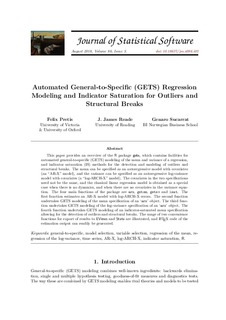Automated General-to-Specific (GETS) Regression Modeling and Indicator Saturation for Outliers and Structural Breaks
Journal article, Peer reviewed
Published version
Date
2018Metadata
Show full item recordCollections
- Publikasjoner fra CRIStin - BI [1015]
- Scientific articles [2181]
Abstract
This paper provides an overview of the R package gets, which contains facilities for automated general-to-specific (GETS) modeling of the mean and variance of a regression, and indicator saturation (IS) methods for the detection and modeling of outliers and structural breaks. The mean can be specified as an autoregressive model with covariates (an "AR-X" model), and the variance can be specified as an autoregressive log-variance model with covariates (a "log-ARCH-X" model). The covariates in the two specifications need not be the same, and the classical linear regression model is obtained as a special case when there is no dynamics, and when there are no covariates in the variance equation. The four main functions of the package are arx, getsm, getsv and isat. The first function estimates an AR-X model with log-ARCH-X errors. The second function undertakes GETS modeling of the mean specification of an 'arx' object. The third function undertakes GETS modeling of the log-variance specification of an 'arx' object. The fourth function undertakes GETS modeling of an indicator-saturated mean specification allowing for the detection of outliers and structural breaks. The usage of two convenience functions for export of results to EViews and Stata are illustrated, and LATEX code of the estimation output can readily be generated.
